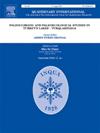Evaluating the accuracy and limitations of the Geotek X-ray fluorescence core scanner fundamental parameter method for the estimation of elemental concentrations in sediment samples
IF 1.8
3区 地球科学
Q3 GEOGRAPHY, PHYSICAL
引用次数: 0
Abstract
X-ray fluorescence core scanners (XRF-CSs) are capable of performing high-resolution, nondestructive, and rapid chemical analyses of sediment samples. As such, they have become an essential part of many geological studies, including palaeoenvironmental reconstructions and geohazard assessments, with their applications expanding each year. The primary limitation of XRF-CSs is that, by default, they provide elemental intensities as outputs, which often cannot quantitatively reflect the chemical composition of samples. To address this limitation, the latest generation of Geotek XRF-CSs provides elemental concentrations estimated from element intensities using the fundamental parameter (FP) method as its default output. In this study, we present the first comprehensive evaluation of Geotek XRF-CS-derived estimates by comparing them to certified (‘true’) elemental concentrations reported for 17 various powdered certified reference materials, which are considered representative of sediment samples and are mixtures of air, water, mineral, and amorphous phases. Our goal was to assess the reliability of the instrument's default output under various measurement setups, including different apparatus settings and both wet and dry sample conditions. We found that Geotek XRF-CS estimates are mostly linearly related to true elemental concentrations. However, the latter remain significantly underestimated, particularly when the analysed sample is wet. The relationship between the true concentration and the instrument's estimates becomes proportional when the results are expressed as elemental log ratios, regardless of the measurement setup. In this regard, Geotek XRF-CS estimates resemble the element intensities provided by other XRF-CS systems. We conclude that Geotek XRF-CS estimates are suitable for reliably assessing the relative variability in the chemical composition of sediment samples and its uncertainty. However, their application to fully quantitative analysis may be limited.

评价Geotek x射线荧光核扫描仪基本参数法估算沉积物样品中元素浓度的准确性和局限性
x射线荧光核心扫描仪(XRF-CSs)能够对沉积物样品进行高分辨率、非破坏性和快速的化学分析。因此,它们已成为许多地质研究的重要组成部分,包括古环境重建和地质灾害评估,它们的应用每年都在扩大。XRF-CSs的主要限制是,默认情况下,它们提供元素强度作为输出,这往往不能定量地反映样品的化学成分。为了解决这一限制,最新一代Geotek XRF-CSs使用基本参数(FP)方法作为默认输出,提供从元素强度估计的元素浓度。在本研究中,我们首次对Geotek xrf - cs估算值进行了全面评估,将其与17种不同粉末认证标准物质的认证(“真实”)元素浓度进行了比较,这些标准物质被认为是沉积物样品的代表,是空气、水、矿物和无定形相的混合物。我们的目标是评估仪器在各种测量设置下的默认输出的可靠性,包括不同的设备设置和干湿样品条件。我们发现Geotek XRF-CS估计与真实元素浓度基本呈线性关系。然而,后者仍然被严重低估,特别是当分析的样品是湿的。当结果表示为元素对数比时,无论测量设置如何,真实浓度与仪器估计值之间的关系都成正比。在这方面,Geotek XRF-CS估计类似于其他XRF-CS系统提供的元素强度。我们得出结论,Geotek XRF-CS估计适用于可靠地评估沉积物样品化学成分的相对变异性及其不确定度。然而,它们在完全定量分析中的应用可能受到限制。
本文章由计算机程序翻译,如有差异,请以英文原文为准。
求助全文
约1分钟内获得全文
求助全文
来源期刊

Quaternary International
地学-地球科学综合
CiteScore
5.60
自引率
4.50%
发文量
336
审稿时长
3 months
期刊介绍:
Quaternary International is the official journal of the International Union for Quaternary Research. The objectives are to publish a high quality scientific journal under the auspices of the premier Quaternary association that reflects the interdisciplinary nature of INQUA and records recent advances in Quaternary science that appeal to a wide audience.
This series will encompass all the full spectrum of the physical and natural sciences that are commonly employed in solving Quaternary problems. The policy is to publish peer refereed collected research papers from symposia, workshops and meetings sponsored by INQUA. In addition, other organizations may request publication of their collected works pertaining to the Quaternary.
 求助内容:
求助内容: 应助结果提醒方式:
应助结果提醒方式:


